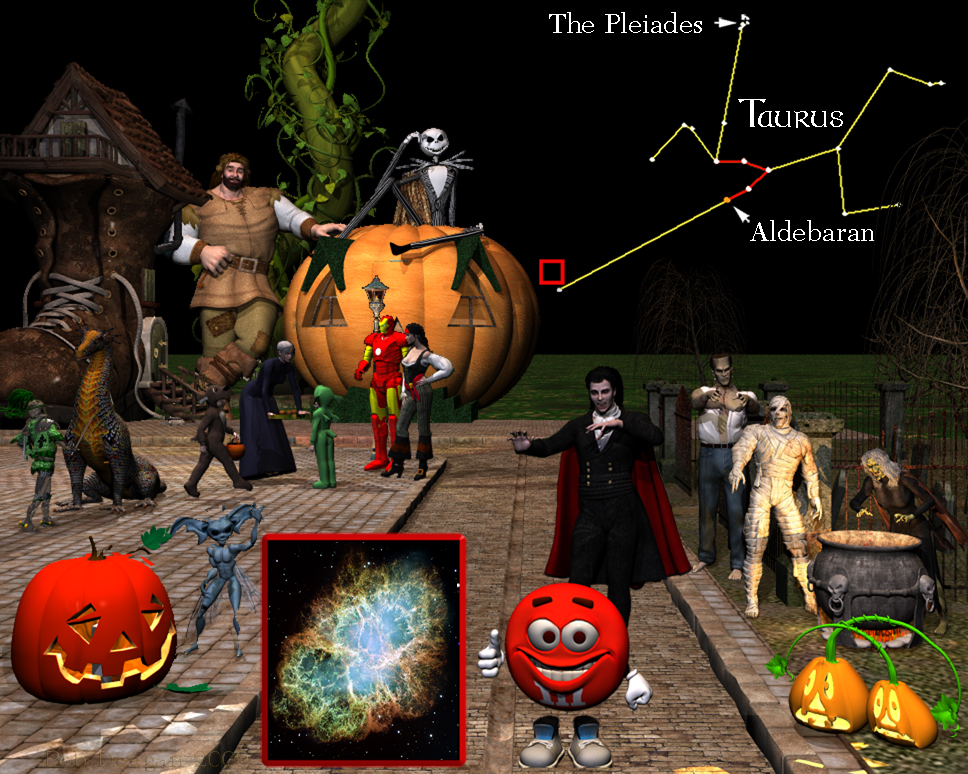
For the week including October 31, 2009

HALLOWEEN STARS
As trick-or-treaters are out enjoying this coming Halloween night, the constellation of Taurus, the Bull, will extend along the eastern horizon. It’s hard to pick out the shape of a bull among these stars, but the constellation is so filled with celestial “landmarks” that Taurus is easily found in the sky. These landmarks, the Pleiades, Hyades, and the bright star Aldebaran are immediately apparent, even on hazy nights.
At the center of the constellation is the V-shaped Hyades star cluster which forms the face of the Bull. To the unaided eye the Hyades looks like a loose collection of a dozen or so stars, but binoculars show that it’s actually a swarm of hundreds of stars. The Hyades cluster is in motion — moving through space at a leisurely twenty-six miles a second. This is the second-closest moving cluster to the Earth. Only the stars that form the moving cluster of the Big Dipper are closer.
Looking above the Hyades cluster, you will see that Taurus contains its own tiny “dipper” of stars. This is the famous Pleiades star cluster, also known as the “Seven Sisters”. The Pleiades is the best-known open cluster in the sky due to its distinctive shape, size, and brightness. Mentioned frequently in ancient writings, the Pleiades contains over 250 members, with a dozen or so visible to the naked eye. Looking at the Pleiades with binoculars, you’ll easily see over fifty young stars.
Rounding off the landmarks of Taurus is the red giant Aldebaran. Arabic for The Follower, Aldebaran is the thirteenth brightest star in the sky. This star has always been associated with the “Bull’s Eye”. Although it fits right in with the Hyades “V”, Aldebaran is not really part of this cluster. It’s actually much closer to us, sitting in the sky as a foreground object. If Aldebaran were as close to us as the Sun is, it would shine sixty-eight times brighter and would look forty times bigger in our sky.
If you own a telescope, look for the Crab Nebula just off the tip of the Bull’s eastern horn. Shown in the Hubble Space Telescope photograph at lower center, this nebula is composed of debris expanding away from a star that exploded in a supernova. By tracking the expansion of the debris backward, astronomers were able to determine that the star exploded in 1054 AD. Research into various world histories turned up Chinese records which spoke about a highly unusual “guest star” that appeared at that time. It burned its way into the afternoon sky and was visible during the day for weeks. At night it glowed brighter than the full Moon. The flash of the explosion gradually faded away but had been visible for over a year. The Anasazi and Mimbres Indians who lived in the regions of present-day Arizona and New Mexico also seem to have recorded the supernova in their artworks.
Special thanks go to Leon Johnson for contributing an impetus toward creating this site!
Unless otherwise indicated, all content of this web site is the copyright of Robert Deegan and all rights are reserved.
For more information, or to comment, please contact: Bob@NightSkies.org